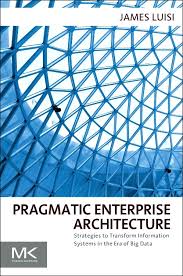White Paper: Mastering Enterprise Architecture with "Pragmatic Enterprise Architecture"
Abstract
Enterprise architecture (EA) is a critical discipline that enables organizations to align their IT strategies with business goals. James Luisi's "Pragmatic Enterprise Architecture" provides a practical and actionable approach to EA, guiding organizations through the complexities of designing, implementing, and governing enterprise architectures. This white paper delves into the key concepts, methodologies, and best practices presented in the book, exploring how to effectively apply EA to drive business success.
Introduction
Enterprise architecture provides a blueprint for an organization's IT infrastructure, applications, and data. By understanding the principles of EA, organizations can improve their agility, reduce costs, and enhance their ability to adapt to changing business needs. This white paper aims to provide a comprehensive overview of EA, drawing inspiration from Luisi's pragmatic approach.
Key Concepts of Enterprise Architecture
- Business Architecture:
- Business Capabilities: Identifying the core competencies of an organization.
- Business Processes: Mapping out the processes that support business objectives.
- Business Functions: Defining the organizational structure and roles.
- Information Architecture:
- Data Models: Designing data models to represent business information.
- Data Governance: Establishing policies and procedures for data management.
- Data Quality: Ensuring data accuracy, completeness, and consistency.
- Application Architecture:
- Application Portfolio Management: Identifying and managing the organization's applications.
- Application Integration: Integrating applications to share data and services.
- Application Development Standards: Enforcing coding standards and best practices.
- Technology Architecture:
- Infrastructure Architecture: Designing the underlying infrastructure, including hardware, networks, and virtualization.
- Technology Standards: Defining standards for hardware, software, and protocols.
- Security Architecture: Implementing security measures to protect information assets.
Best Practices for Enterprise Architecture
- Align with Business Strategy: Ensure that the EA aligns with the organization's strategic goals.
- Foster Collaboration: Encourage collaboration between business and IT stakeholders.
- Prioritize and Focus: Focus on high-impact initiatives and avoid unnecessary complexity.
- Measure and Monitor: Track the effectiveness of EA initiatives and make adjustments as needed.
- Continuous Improvement: Embrace a culture of continuous improvement and innovation.
Real-World Applications of Enterprise Architecture
- Digital Transformation: Enabling digital transformation initiatives by aligning IT with business goals.
- Cloud Migration: Planning and executing cloud migration strategies.
- Data Governance: Ensuring data quality, security, and compliance.
- Application Modernization: Modernizing legacy applications to improve performance and scalability.
- Mergers and Acquisitions: Integrating IT systems and data from different organizations.
Conclusion
Enterprise architecture is a critical discipline that can significantly impact an organization's success. By following the principles and practices outlined in "Pragmatic Enterprise Architecture," organizations can achieve greater agility, efficiency, and innovation. By embracing a pragmatic approach to EA, you can effectively navigate the complexities of the digital age and drive business transformation.
References
- Luisi, J. (2013). Pragmatic Enterprise Architecture: A Foundation for the Digital Enterprise. McGraw-Hill Education.
- The Open Group Architecture Framework (TOGAF): A widely adopted framework for enterprise architecture.
- Zachman Framework for Enterprise Architecture: A framework for organizing enterprise architecture information.
By combining the theoretical knowledge from "Pragmatic Enterprise Architecture" with practical experience and a focus on continuous improvement, you can become a skilled enterprise architect and contribute to the success of your organization.



